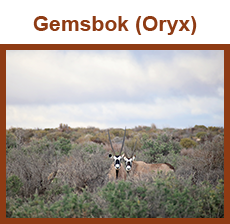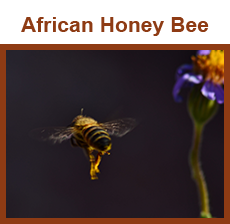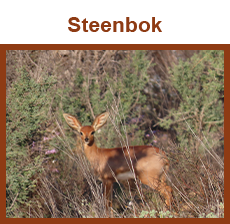 |
{ Least Concern }
Courtesy of a Guest |
|
This antelope is perfectly suited to the arid conditions in the Cederberg due to ‘carotid rete’. This network of blood vessels is located in the nasal cavity of the species; the rapid circulation of air through the nostrils cools the blood stream in the muzzle before it is pumped to the brain, which keeps the antelope from overheating. During the drier seasons Gemsbok do not sweat, thus preserving their bodily water sources. |
|
 |
{ Not Threatened }
Courtesy of Ranger Shaun |
|
While the humble Honey Bee is not threatened, as is widely believed, they are an integral part of the eco-system; without which, many species of plant and animal life would become extinct, or be affected. Bees in this region are even more precious as they assist in pollenating the fynbos, on which our wildlife depends. Pictured is a Honey Bee carrying pollen after visiting a Hongerblom. |
|
 |
{ Least Concern }
Courtesy of Ranger Shaun |
|
Also referred to as ‘Dwarf Antelope’, the Steenbok is a common species in South Africa, which is rather petite. Steenkok weigh between 7 and 16 kilograms and have a wide diet, consisting mainly of leaves, as well as roots and bulbs during the drier months. Steenbok do not have a specific breeding season and will reproduce throughout the year; pairs remain monogamous for their lifespan. |
|
|
While the year 2020 may not have been kind to the human population of the world, the wildlife at Kagga Kamma Nature Reserve has thrived. This year has seen a drastic increase in rainfall, nearly double, in fact, of that which blessed the plains in 2019. As a result, the spectacular wild flowers have blanketed the fynbos in an array of brilliant hues this spring and the Eland and Springbok herds on the property have welcomed new-borns amongst their ranks.
The most exciting news of the spring season, however, is the announcement of the birth of a Bontebok calf; its debut with the herd, during September, excited the Rangers and staff at Kagga Kamma. Bontebok are endemic to the region and a small population remains, due to overhunting by European settlers during the 18th and 19th centuries. The Bontebok species’ numbers dwindled dangerously low, to less than 30 known individuals, before the Bontebok National Park was established to protect them. Today it is believed that approximately 3000 Bontebok individuals exist worldwide.
This species is dependent on rainfall to ensure a viable habitat for population growth. While the previous years did not yield enough of this precious sustenance, 2020 provided ample rain for the foliage to flourish and the first Bontebok calf to be born in recent years. The Kagga Kamma Team is excited to follow this little one’s journey. Hopefully, with sufficient and steady rainfall in the years to come, we may see further population growth of this beautiful animal in the Nature Reserve. |